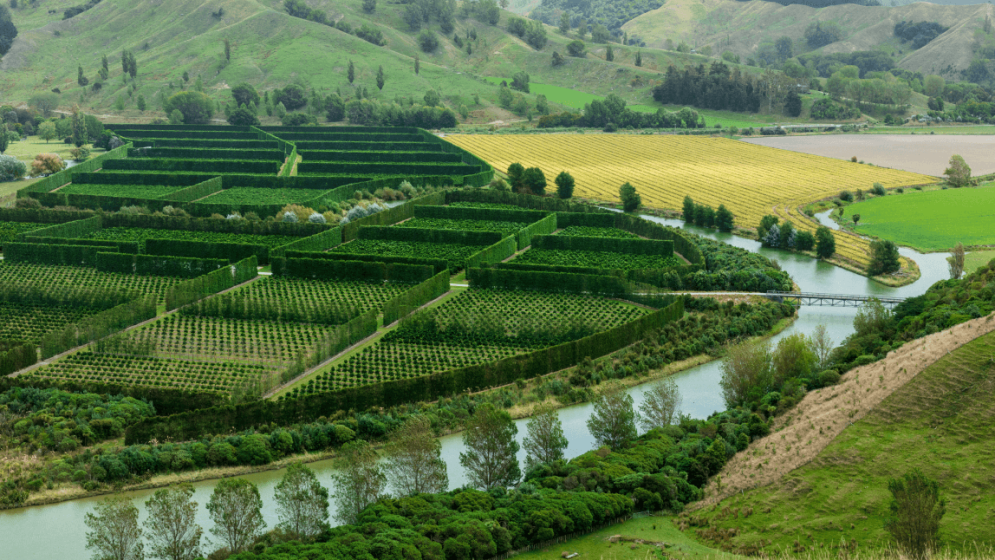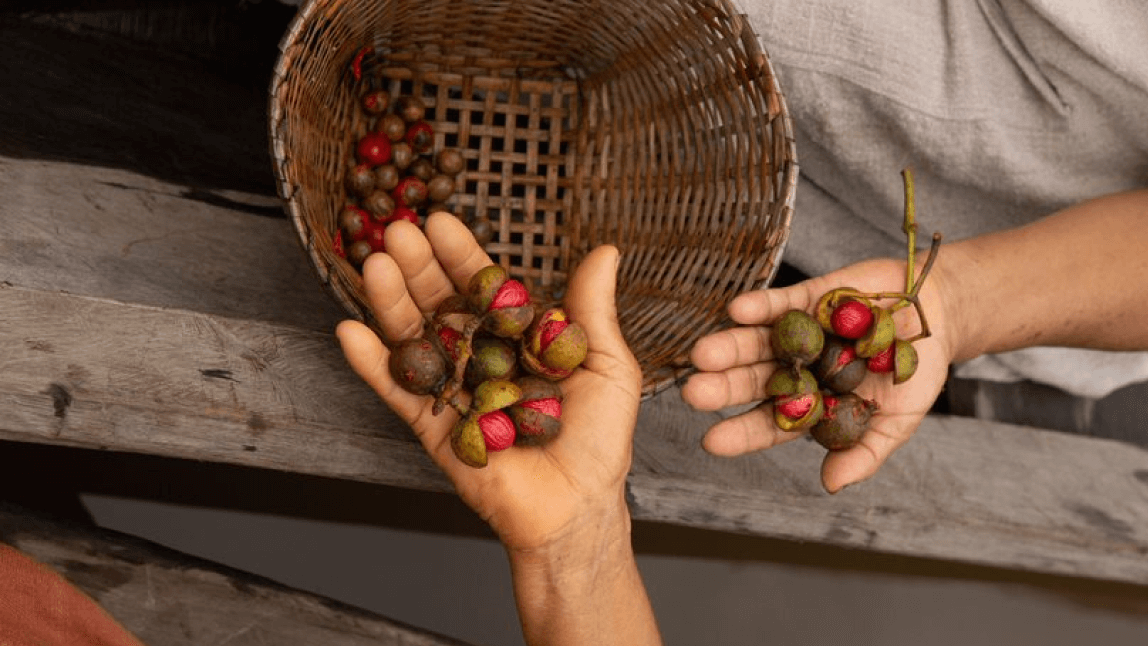name:
Orongo Cattle Station
origin:
New Zealand
“I cannot imagine more satisfying work than to operate between farming, cultural history, ecological history, prehistoric ecological history”
- Thomas Woltz
The Orongo Station is a 3,000 acre coastal farm located on the north Island of New Zealand. The farm had existed for over a century, before new owners took it over in 2001. At this time, because of overgrazing and deforestation, large areas of the farm were suffering from soil erosion and the quality of the grazing land was poor. Furthermore, a large wetland had been drained, destroying the habitat for many birds, insects and other wildlife. In short, the new owners were confronting an ecological disaster.
Fast-forward twenty years, and Orongo Station is more productive than ever, producing sheep, cattle, citrus fruit and timber products through an integrated farming system.
The restoration of the farm was achieved through a process of conscious design, led by the landscape architect firm Nelson Byrd Woltz. At the heart of the design is the desire to integrate three interconnected layers within the land – the farm landscape, the cultural landscape and the ecological restoration of the land.
The result: the farm is financially lucrative and resilient, the local Maori have greater access to the land and one of their ancient burial grounds has been expanded. Most remarkably, almost a fifth of the land has been ‘retired’ for wildlife zones, including the creation of an ecological niche for one of New Zealand’s rarest reptiles, the tuatara lizard.

Citrus grove bounded by the winding form of the Maraetaha River (photo: Daniel Shipp)
Why it is an example of the circular economy
The dominant method of farming for the last hundred years has been an industrial model characterised by high chemical use and very intense management of land. For years this extractive mode of farming did lead to increased yields, but the longer term legacy has been the gradual degradation of natural systems. According to a 2017 UN study, up to a third of the planet’s land is now severely degraded, mainly caused by intensive agriculture. Land degradation also leads to habitat destruction, so that food production is also the main contributing factor to biodiversity collapse.
At the same time as soil and wildlife are being destroyed, the global population is expanding and demand for food is increasing. It has been estimated that to feed the 3 billion expected extra people in 2050, will require an area about twice the size of India. To avoid expanding into virgin wilderness and to protect valuable carbon sinks and precious wildlife habitats, we must look at ways of healing our existing farmland.
Fortunately there are alternative ways to produce food and steward land, which means that agriculture can be a major solution, not only reversing the degradation but becoming nature positive. The restoration of the degraded Orongo Cattle Station is one such example, showing that farming does not need to be a zero-sum game, that in fact farm productivity, carbon sequestration, thriving wildlife and cultural traditions can exist together.
How Orongo Station was restored
Having articulated the three important layers of - farm, culture and ecology - whole system thinking was applied to bring all the complexities of the site into an integrated and coherent whole.
The development of the future farm’s detailed masterplan was informed by research into every aspect of the land, culture and farm activities, such as water tables, flood cycles, native plants, harvesting methods, cultural history and the habits of migratory birds. All of these factors informed the final layout of the farm.
To give some examples of the factors that influenced the design:
A 200-acre wetland had been drained creating a muddy mess during the wet season unsuited to grazing. The ecological restoration called for the re-establishment of the wetland with a series of pathways, ponds and polders. S-shaped dams allowed separation of freshwater from saltwater to enhance habitats and wildlife diversity.
One migratory bird species needed a minimum of 1.6 hectares so the wetland plan included islands of this size.
Invasive species like stoats, weasels and rats had gotten out of hand, eating the eggs of burrowing birds and threatening the ecological balance. One mechanism to address this was to include steeper foraging slopes providing certain species with a safer lookout.
An important 300-year old Maori burial ground existed on the land that needed to be respectfully incorporated into the plan.
A work of art in service to wildlife
Lead architect Thomas Woltz views the landscape as a canvas, and the final farm masterplan resembled an abstract painting with measurable factors such as habitat islands, burial grounds, protective slopes and machine turning radii, as fixed points in the composition.
If the land is a canvas, then its undercoat is the 600,000 trees which were planted as the foundation for the farm’s journey of restoration. The natural vegetation of the region is temperate rainforest, but as the farm operation developed most of the trees were cut down. To facilitate the scale of afforestation, the original plan encouraged incentivizing local Maori people to collect seeds from local forests, which would then be propagated in a nursery and sold back to the farm. Now that the restoration of the farm has been completed, the Maori's access to the land has been expanded for harvesting, fishing and other traditional activities.
The trees provide valuable ecosystem services such as timber for construction, food for pollinators, the prevention of soil erosion, protective barriers for the citrus groves and the creation of a linear forest habitat for a modern-day dinosaur.
A new home for a dinosaur
Before 1300, there were no significant mammal populations in New Zealand. This allowed indigenous birds and reptile life to thrive. The arrival of humans, first the Maori and later the Europeans, led to invasive species and habitat destruction, meaning many species became extinct, particularly ground-dwelling creatures such as the moa which had not evolved to defend against the influx of predatory stoats, weasels and rats.
One animal that has suffered is the tuatara lizard (sphenodon punctatus), an ancient reptile unchanged for over 200 million years. The natural habitat of the tuatara is now confined to 32 outlying islands, with no wild populations found on mainland New Zealand. Two key threats that have precipitated the decline of the tuatara is predation by the polynesian rat (rattus exulans) which feeds on reptile’s eggs as well as a very special relationship that tuatara have with certain species of sea-birds.

The tuatara lizard – one of our closest direct links to dinosaurs (image - Karissa Best from Unsplash)
For tuatara to thrive, they rely on a symbiosis with certain sea-bird species – two types of petrel and one type of shearwater, none of which had been seen on the shore for 100 years. The tuatara co-exist with these birds as they can re-use the bird’s burrows for their own nests, as well as acquire food in the form of an occasional egg, and by eating the insects that feed on the bird’s guano.
To provide a suitable habitat for the tuatara, a corner of the farm was fenced off that contained 80,000 trees and a steep cliff edge. To encourage the sea-birds to return, a solar-powered speaker was set up on the cliff, that each night broadcast the sounds of sea-birds, so that a colony was soon established. After a number of years of forest growth and at least three nesting cycles, the New Zealand Wildlife Authority and local Maori conservation group, decided that the enclosure was a suitable habitat to maximise the chance of successful breeding and in 2012 sixty-five tuatara adults were introduced into the enclosure. Shortly after the first tuatara eggs were successfully hatched.
The decision to release the tuatara onto the Orongo Station land is a spectacular affirmation of the successful transformation of a degraded landscape into one of the richest and most biodiverse ecologies in the region. To restore the vast tracts of land around the world that have been destroyed by industrial agriculture, more farmers and landowners need to follow Orongo’s example that provides abundance in food, culture and ecology.






